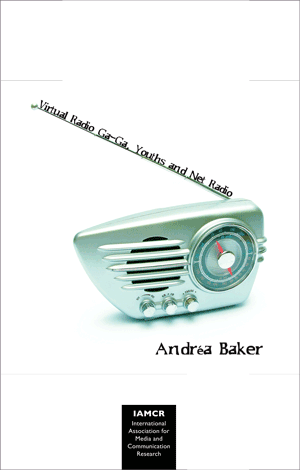Virtual Radio Ga-Ga, Youths and Net Radio: Exploring Subcultural Models of Audiences | |
|  | Quantity in Basket:none
Code: 978-1-61289-070-8
Price:$85.00
Title: Virtual Radio Ga-Ga, Youths and Net Radio
Sub-title: Exploring Subcultural Models of Audiences
Author(s): Andrea Baker
Publish Date: March 2012
Pages: 316
Format: Cloth
| |
| Primarily based on a transnational study of college students’ net-radio consumption practices, this book uncovers two types of audiences (radio online or net-only radio audiences) and a three-tiered net-radio subculture (conservatives, swingers, and radicals), which is determined by users’ taste distinctions and how much power they have over their net-radio consumption and production practices. It contends that net-radio, its synergy with radio and music journalism and youth subcultures is not a trivial flash in the pan, but an important and ongoing social-cultural and global phenomenon. In doing so the book contributes to cultural studies research on the Internet.
Contents: INTRODUCTION: VIRTUAL RADIO GA GA AND ITS TYPICAL YOUTH STREAMS. Introduction. Author’s Background and Radio Definitions. From Traditional Radio to Net Radio. The Evolution of Net-Radio and its Associated Audiences. Research Methdology. Other Key Terms. Gaps in the Literature This Book Aims to Address. Significance of this Book. Book Structure. RESEARCH METHODS: DESPARATELY SEEKING A NET-RADIO AUDIENCE. Introduction. Studying Net-Radio Audiences. Culture and Identity: (An Academic Framework to Studying Net-Radio Audiences. Research Design (Mixed Methods Research). Conclusion. FROM TEDDY BOYS TO POST-HIPSTERS: EXPLORING SUBCULTURAL MODELS FOR YOUTH NET- RADIO AUDIENCES. Introduction. Research into Youth Subcultures. Class, Political Ideology, and Resistant Practices. Social Class, Ethnicity, and Gender. The Politics of Life (Style). Media and Commoditization. Youth Net-Radio Hierarchy. Net-Radio Consumption as Niche Media. Conclusion. DID THE INTERNET KILL THE RADIO STAR? RADIO 360 VIRTUAL DEGREES: HISTORY AND THE DEVELOPMENT OF NET-RADIO. Introduction. Regulation. Development of the Internet. Institutional Models. Content and Audience Formations. Conclusion. RADIO LEFT OF THE DIAL: COLLEGE NET-RADIO. Introduction. College Radio: The Beginnings. Conclusion. RADIO ONLINE OR NET-ONLY RADIO? SURVEY ANALYSIS OF YOUTH NET- RADIO AUDIENCES. Introduction. Sample and Characteristics of Respondents. The Youth Net-Radio Audience. Radio Online and Net-Only Radio Audiences. Conclusion. NET-RADIO WITHOUT BOUNDARIES—THE RADICALS, SWINGERS, AND CONSERVATIVES: A TRANSNATIONAL CASE STUDY OF YOUTH NET-RADIO USERS. Introduction. Reasons for Tuning Into Net-Radio Instead of Traditional Radio. Ethnicity, Geography, and Radio Online Consumption. Net-Radio as Empowerment and Resistance to Dominant Formats. 3-Tiered Net-Radio Subculture. Conclusion. CONCLUSION: WILL COMPETING AUDIO TECHNOLOGIES KILL THE NET- RADIO STAR? Introduction. Implications of the Research. Radio Online or Net-Only Radio Users. Three-Tiered Subculture. Addressing the Net-Radio Research Deficit. Competing Technologies (Digital and Satellite Radio). Net-Radio Devices (Flytunes, iRadio, Aluratek, USB, Tivoli’s Networks. Future Directions. Suggestions for Future Research. Appendixes. Bibliography. Author Index. Subject Index.
|
| |







